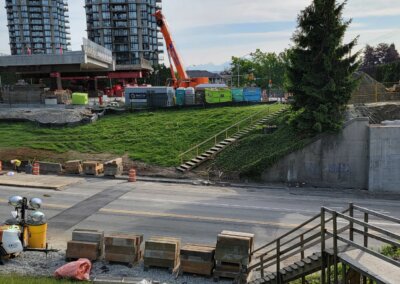About the Project
The Royal Avenue Underpass (the Underpass) rehabilitation was part of the City of New Westminster roadwork and structure improvements portion of the overall design-build Pattullo Bridge Replacement Project (PBRP). Originally designed and constructed in 1954, the Underpass had exceeded its design life, had durability issues, and did not meet the current seismic design requirements. Hatch as the prime designer for the design-build contractor rehabilitated and restored the Underpass through a variety of sustainable and innovative methods. While replacing the Underpass with a new concrete structure is a simple way to meet design requirements, it is not environmentally sound as both demolition and production of concrete result in significant greenhouse gases (GHG) emissions. Through careful investigation and design, Hatch rehabilitated the Underpass to meet current seismic standards and project durability criteria by salvaging the original abutments, wingwalls, and approach embankments, and pre-assembling the superstructure in a nearby staging area. Hatch was mandated to set public interest in environmental sustainability as a priority during restoration. The superstructure replacement was completed using a self-propelled modular transporters (SPMT) system. Use of an SPMT system eliminated use of cranes and heavy equipment for demolishing the structure, reducing fossil fuel use and traffic disruptions by minimizing the duration of the required closure to a single weekend. Retrofitting parts of the Underpass also saved new concrete from being produced, thus, reducing GHG emissions while working towards net zero infrastructure. Connecting the cities of New Westminster and Surrey, the upgraded Underpass plays an important role in connecting people. In addition to carrying vehicular traffic, the Underpass completed a missing sidewalk connection linking to the Victoria Hill community and will connect directly to a new 4km network of multi-user paths built as part of the PBRP.
Approach
The Royal Avenue Underpass is located at the north approach of the Pattullo Bridge, grade separated from Royal Avenue. To minimize traffic disruption while striving for net zero emissions, Hatch provided an environmentally thoughtful approach of salvaging the existing structure to achieve a solution that was well-perceived by the public, with minimal community impacts through construction.
First, Hatch performed a condition assessment and seismic evaluation of the structure to seek opportunities for repair and salvage. Abutments were retrofitted to extend the service life to the current standard and project requirements. When Hatch found that the superstructure was not repairable or compatible with the current seismic requirements, seismic pins were used to fully utilize the new superstructure by rigidly connecting it to the top of the walls, allowing the entire structure to act as a single semi-rigid frame and optimizing seismic loading on the retrofitted walls. By saving the original abutments, temporary work was reduced, which resulted in less traffic disruptions above and along the bridge connector.
Hatch planned a staged superstructure installation to reduce road closure hours. Using computer operated SPMT, the existing bridge deck was jacked up and then moved to the nearby staging area (at the exit ramp) for demolition. The new superstructure was prefabricated at the staging area and then lifted and moved into place using the SPMT.
Results
Hatch met all stakeholder, contractor, operational, and safety requirements by using sustainable and innovative methods to replace the Underpass. By retrofitting abutments and restoring the concrete facing instead of completely replacing them, Hatch preserved over 400 m3 of concrete. Hatch minimized the usage of heavy-duty construction and lifting equipment by assembling the superstructure close to the site and using SPMT to erect the bridge, resulting in fewer detours and road closures.
Service(s) Provided
• Road and highway design
• Bridge and structural design
• Active transportation design
• Condition and durability assessment
• Geotechnical analysis
• Utility protection and relocation
• Permanent design
• Service life extension of the foundation and abutments
• Signage and pavement marking
• Construction monitoring and Engineer of Record services
• Engineering management services
Project Team (Consultants)
Thurber
EXP
GNEC
Project Team (Contractors)
Fraser Crossing Constructors General Partnership
Go back to projects in
View other projects from
Stay in touch with us
Subscribe to our mailing list!
Organization
Connect






